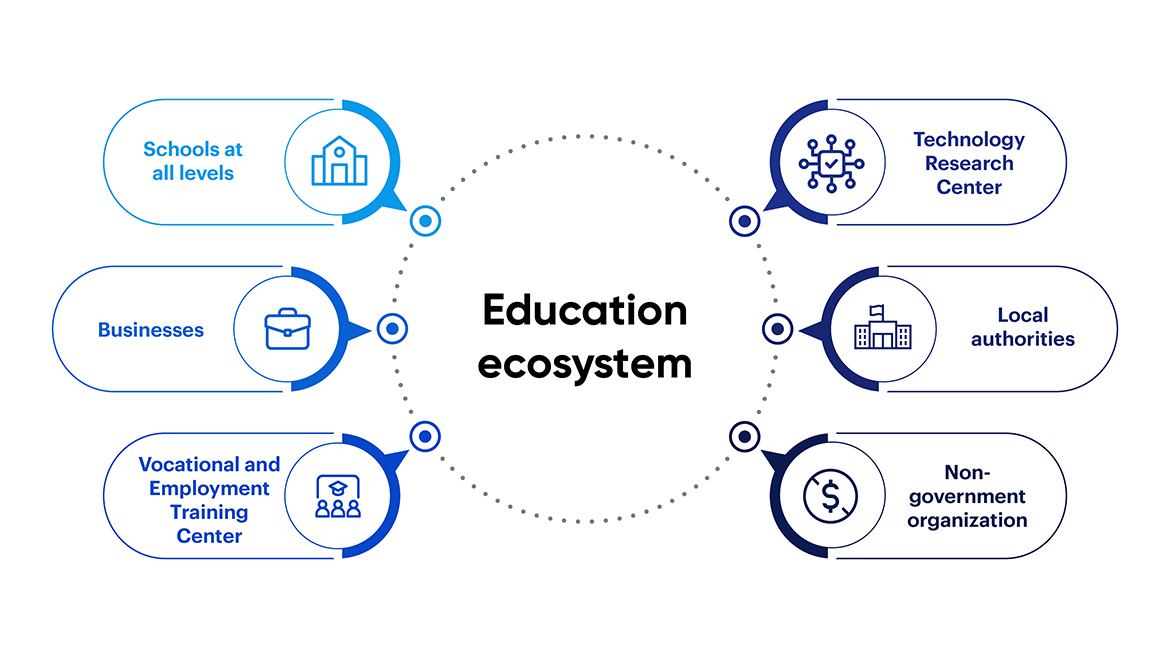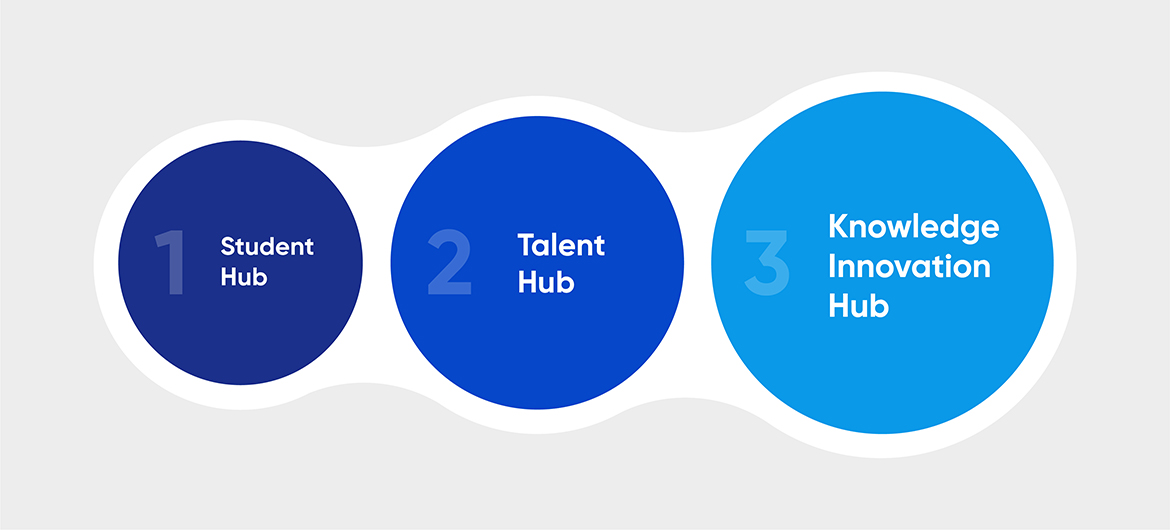Currently, as science and technology are evolving rapidly, knowledge has become a measure of the future development and forecast of an economy, such as the World Economic Forum’s Global Competitiveness Index (GCI), which will be evaluated in part based on the quality of education. human resources and innovation capacity. For sustainable socio-economic development, human resources will be needed to meet the increasing requirements of the labor market in the era of technology 4.0 with many constant changes.
General model
Investing in education and building an education ecosystem is a long-term strategic focus of many countries. It includes a network of schools at all levels, enterprises, technology research centers, vocational and employment training centers and local authorities,… in order to create a comprehensive educational environment. From there, create socio-economic values to improve the competitiveness of the nation.

Benefits of the education ecosystem
A complete educational ecosystem that helps to develop a sustainable socio-economic based on knowledge and offers fundamental benefits such as:
- Attract and retain talented young people to stay locally with international quality study programs of prestigious universities with many opportunities to experience and improve skills at affiliated companies. This economic benefit not only helps to reduce the brain drain in many localities and countries but also attracts more talent from many places to build the economy.
- Meet the high requirements of the 4.0 industrial economy and solve the problem related to the shortage of specialized technical skills and improve the digital level. Since then, it has formed a skilled workforce for key economic sectors, contributing to improving the competitiveness of locals and nationalities.
- Attracting many foreign investment sources and large corporations with high-tech research centers creates an environment to promote innovation with new values and new solutions.
- Promote commercial activities and create jobs in the fields of R&D innovative technology research through linkages with businesses and industry partners.
Three levels of the education ecosystem

Student Hub – The general education model is the most popular model in the present including the coordination of the school system at education levels to provide an inter-level roadmap from preschool to PhD. In addition to cultural subjects, students will focus on developing soft skills, digital skills and foreign languages. International schools will be encouraged to set up branch facilities and cooperate with domestic schools to provide international quality programs for students and improve the capacity of local schools, especially at the university and college level.
Talent Hub – The talented education model will have a higher economic and social impact with the goal of developing high-quality human resources according to the market demand in that locality. This model is a combination of international higher education institutions as well as private training/education companies which are encouraged to provide academic programs and career development opportunities for young talent and equip workers with additional skills related to technology and innovation. The peculiarity of this model will be universities, colleges and vocational training centers will train human resources that are suitable to the economic development sectors of that region, to promote faster development.
Knowledge & Innovative Hub – The model of knowledge education and innovation is the model with the largest impact and brings the most socio-economic value. This model is a complete educational ecosystem with direct contributions from universities, colleges, vocational schools, research institutes, and businesses in the professions. With common development benefits, these components will work with local partners to research and apply innovation initiatives to increase local competitiveness. Businesses will directly participate and become research and development, applications and technology transfer centers. Hence, this model will support the development of the startup ecosystem that promotes innovation (1).

Vietnam is forming and developing large-scale educational complexes at a high level, typically to FPT Education system of FPT Group. With the mission of providing globally competitive human resources and contributing to the development of industry 4.0, FPT Education was formed based on the close links of inter-level schools from preschool to university, International Linkage, International Student Development, Institute of Business Administration, Institute of Technology Research of FPT Corporation. In addition, there are FPT Global Innovation Company, Functional Boards and incubator projects.
FPT Education is an example of a talent education model focused on innovative IT knowledge and soft skills that contribute to the creation of high-quality human resources with global competitiveness. FPT Education has a network of 180 global partners and more than 40 countries to improve the quality of teaching according to international standards. In particular, FPT’s model of Education and Software Park Complex (including businesses and universities) in 4 key economic regions of the country including Hanoi, Da Nang, Ho Chi Minh City, Can Tho, and Binh Dinh in the future creates conditions for students to experience industry 4.0 practices. This education ecosystem is a pioneer in training a large number of IT human resources to thousands of graduates each year, contributing to the modern technology ecosystem and the development of Vietnam’s concentrated IT parks and high-tech parks as well as helping Vietnam improve its position in the global technology value chain.

Currently, FPT Institute of Technology has become a bridge between businesses and education with the main function of researching and applying outstanding developments in science and technology, serving the development of domestic industries. The digital initiatives developed will help Vietnamese enterprises increase their competitiveness in the market.
Qatar’s educational city model

Recognizing that its oil-based economy will not last long, Qatar is determined to build an educational city to develop the country’s economy sustainably, self-sufficiency and high-quality human resources. This is an important part of Qatar’s national vision for 2030.
The educational city was built on the outskirts of Doha’s capital covering an area of 14 square kilometers and containing educational institutions from schools and research areas to branches of foreign universities. Most of the programs taught here are in English.
The city of education is a symbol of Qatar’s educational ecosystem. Qatar has partnered with foreign partners such as the University of Virginia, Weill Cornell Medical College, Texas A&M University, Carnegie Mellon University, Georgetown University (USA), HEC Paris University (France), and UCL University (UK) to build branch campuses on its educational city campus. In addition, this is an environment that not only trains students but also helps the exchange of research between schools, strengthening relations between the public and private sectors.
Moreover, the city also has a Qatar Science & Technology Park to promote the development of the knowledge economy by encouraging companies and global research institutes to develop and commercialize their technologies in Qatar. It is home to international technology companies and is the incubator of newly established technology businesses. The introduction of this park with the Advanced Materials Center at the University of Qatar will help the city focus on its development goals in the field of new technology research and development through high-tech training, support for new startups and improve technology management skills (2).
As a result, Qatar has become one of the countries with a high economic competitiveness index in the region with 4th place and in the top 30 in the world in 2019 (3), ranked 1st in the Arab region and 4th in the world in terms of quality of education in 2021 (4).
Reference sources:
(1) Taylor&Francis online. Education hubs: international, regional and local dimensions of scale and scope: Comparative Education: Vol 49, No 3
(2) Qf.org.qa Education City in Qatar
(3) World Economic Forum. 2019 The Global Competitiveness Report
(4) HUKOOMI Qatar e-Government. Qatar Ranked First in the Arab Region and Fourth in the World in Quality of Education 2021





